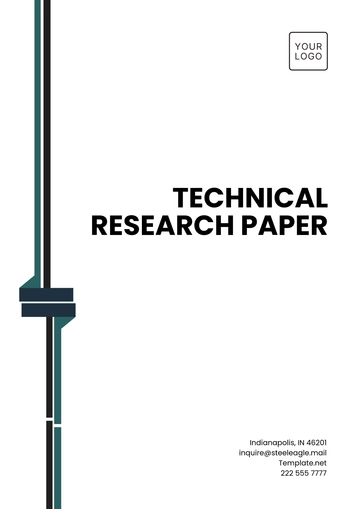Free Professional White Paper

Prepared by: [YOUR NAME], Senior Energy Analyst, [YOUR COMPANY NAME]
Introduction
In an era where policy decisions are becoming increasingly complex and far-reaching, it is crucial for policymakers and stakeholders to rely on comprehensive, data-driven insights. This white paper aims to provide a thorough analysis of Advancing Renewable Energy Integration, offering evidence-based recommendations to guide effective policy development. Prepared by [YOUR NAME], this document is designed to support strategic decision-making and foster informed discussions around Advancing Renewable Energy Integration.
Executive Summary
The integration of renewable energy sources into existing power grids is crucial for advancing sustainable energy solutions and mitigating climate change. This white paper presents a comprehensive analysis of the challenges and opportunities associated with renewable energy integration. It evaluates current strategies, explores innovative solutions, and provides actionable recommendations to enhance grid reliability, increase renewable energy adoption, and reduce carbon emissions. Key recommendations include investing in advanced grid technologies, promoting policy reforms, and fostering public-private partnerships.
Background and Context
The global shift towards renewable energy sources such as solar, wind, and hydro power is driven by the need to reduce greenhouse gas emissions and combat climate change. As nations commit to ambitious carbon reduction targets, integrating these intermittent energy sources into existing power grids presents both technical and regulatory challenges. The growth in renewable energy capacity requires significant upgrades to grid infrastructure and operational practices to ensure reliable and efficient energy delivery.
Problem Statement
Despite substantial progress in renewable energy technology, the integration of these sources into existing power grids remains a significant challenge. Key issues include:
Intermittency: Renewable sources like solar and wind are not always available, leading to potential instability in energy supply.
Infrastructure Limitations: Existing grid infrastructure is often inadequate for handling the variable nature of renewable energy.
Regulatory Barriers: Outdated policies and regulations can hinder the adoption of innovative solutions and technologies.
Addressing these challenges is essential for achieving a sustainable energy future and meeting international climate goals.
Analysis
Intermittency and Grid Stability
Renewable energy sources such as wind and solar are inherently variable. This intermittency can cause fluctuations in energy supply, which can destabilize the grid. Recent studies show that advanced forecasting techniques and energy storage solutions can mitigate these issues. For instance, the integration of battery storage systems can store excess energy generated during peak production times and release it during periods of low production.
Infrastructure Needs
Current grid infrastructure in many regions was designed for centralized, fossil-fuel-based power generation. Upgrading to a smart grid that can dynamically respond to changes in energy supply and demand is crucial. Smart grids use sensors, communication technologies, and automation to enhance grid reliability and efficiency.
Policy and Regulatory Challenges
Regulatory frameworks in many countries have not yet adapted to the needs of a renewable energy grid. Policies that incentivize investment in renewable energy technologies, support research and development, and streamline the permitting process are essential for accelerating integration efforts.
Policy Options
Policy Options
Option 1: Investment in Smart Grid Technologies
Description: Upgrade existing grid infrastructure to incorporate smart grid technologies that can handle the variability of renewable energy sources.
Pros:
Improved grid reliability and efficiency.
Enhanced ability to integrate diverse energy sources.
Cons:
High initial investment costs.
Requires significant coordination among stakeholders.
Option 2: Expansion of Energy Storage Solutions
Description: Increase investment in energy storage technologies such as batteries and pumped hydro storage to address intermittency issues.
Pros:
Provides a buffer against supply fluctuations.
Supports grid stability and reliability.
Cons:
Storage technologies can be expensive.
Long-term environmental impacts of storage systems need further assessment.
Option 3: Policy Reform and Incentives
Description: Implement policies that incentivize renewable energy adoption, streamline regulations, and support research and development.
Pros:
Encourages private sector investment.
Accelerates technology advancement and deployment.
Cons:
Policy changes may face political and public resistance.
Requires ongoing monitoring and adjustments.
Recommendations
Based on the analysis, the following recommendations are proposed:
Invest in Smart Grid Technologies: Allocate resources to upgrade grid infrastructure to support renewable energy integration. This includes adopting advanced grid management systems and enhancing real-time data capabilities.
Expand Energy Storage Solutions: Increase funding for research and development of energy storage technologies. Develop incentives for the deployment of storage systems at both utility and residential levels.
Reform Policies and Regulations: Advocate for updated policies that facilitate renewable energy integration. Promote incentives for clean energy investments and streamline regulatory processes to support new technologies.
Conclusion
Integrating renewable energy into existing power grids is a complex but essential task for achieving a sustainable energy future. By investing in smart grid technologies, expanding energy storage solutions, and reforming policies, stakeholders can overcome the challenges associated with renewable energy integration and contribute to global climate goals.
References
Smith, J., & Lee, R. (2053). "Advancements in Grid Technology: A Comprehensive Review." Journal of Energy Research.
Brown, K. (2054). "Energy Storage Solutions: Current Trends and Future Directions." Energy Storage Journal.
GreenTech Solutions. (2054). "Renewable Energy Policy Analysis Report."
Contact Information
For further inquiries or follow-up, please contact:
[YOUR NAME]
[YOUR EMAIL]
[YOUR COMPANY NAME]
[YOUR COMPANY NUMBER]
[YOUR COMPANY ADDRESS]
Date: August 22, 2055
- 100% Customizable, free editor
- Access 1 Million+ Templates, photo’s & graphics
- Download or share as a template
- Click and replace photos, graphics, text, backgrounds
- Resize, crop, AI write & more
- Access advanced editor
The Professional White Paper Template from Template.net offers a sleek, customizable, and fully editable design to suit any business needs. Easily adjust content using the AI Editor Tool for quick revisions and polished presentations. This versatile template saves time while ensuring high-quality results, perfect for professionals seeking a refined, professional document.





























